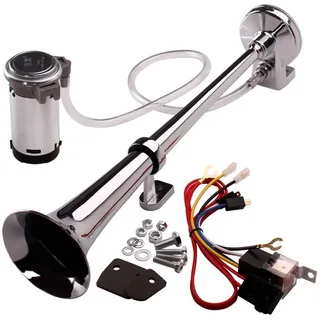Rev Up Your Ride: A Comprehensive Guide to Car Train Horn Kit

Are you ready to take your ride from ordinary to extraordinary? Imagine cruising down the road, turning heads with a commanding horn that echoes like a train barreling down the tracks. A horn kit is not just an accessory; it’s an attitude statement and a safety feature rolled into one powerful package. Whether you're looking to add some fun flair or enhance your vehicle's presence on the road, installing a car train horn kit can elevate your driving experience. But before you dive headfirst into this thrilling upgrade, there’s plenty to consider.
Installation Guide for Car Air Horn Kit
Installing a car air horn kit can feel like an exhilarating DIY project. First, gather your tools: wrenches, screwdrivers, and some electrical tape. You’ll want to have everything at arm's reach to keep the momentum going.
Next, find the perfect spot for your horns. The front grille is often ideal for both sound projection and aesthetics. Securely mount the horns using brackets or screws provided in your kit. Make sure they’re angled downward slightly; this helps prevent water damage.
Once mounted, it’s time to connect the airline. Carefully attach one end of the tube to each horn and secure it with clamps—no leaks allowed! Then route the other end back towards your compressor unit.
For wiring, locate a power source under your dashboard or hood. Connect wires from the compressor to this source while ensuring all connections are tight and insulated with electrical tape for safety.
Test your setup before hitting the road! Give that horn a blast—it should fill you with pride as you hear its thunderous roar echoing around you. Your vehicle is now equipped with a captivating sound that will certainly turn heads wherever you go!
Legal Regulations for Using Train Horns in Vehicles
Before you blast your new horn kit, it's crucial to understand the legal landscape surrounding its use. Different states and municipalities have varying regulations aimed at ensuring public safety and minimizing noise pollution. Some jurisdictions may restrict the decibel level or frequency of sound produced by vehicle horns.
In many areas, using a train horn on public roads can be considered illegal if it creates excessive noise that disturbs the peace. Fines for violating these laws can add up quickly, so always do your homework before hitting the road with your powerful setup.
Certain places allow train horns but only during specific circumstances, like in emergency situations where alerting others is necessary. Familiarize yourself with local traffic laws to avoid unnecessary run-ins with law enforcement.
Commercial vehicles often have more lenient rules regarding horn usage; however, personal cars might face stricter scrutiny. If you're unsure about what’s permissible in your area, consider reaching out to local authorities for clarity.
With great power comes great responsibility—so don’t let excitement cloud judgment when it comes to making some serious noise! Always respect those around you while enjoying that thunderous soundscape you've installed under your hood.
Tips for Maintaining the Train Horn Kit for Truck
Maintaining your Train Horn Kit for Truck isn’t just about keeping it loud; it’s about ensuring your ride stays safe and functional. Start by giving your horns a thorough inspection every few months. Look for rust or corrosion, especially if you often drive in wet conditions.
Next, check the air compressor regularly. This is the heart of your setup, pumping life into those powerful blasts. Clean any debris from the intake filter to ensure optimal performance. A clogged filter can lead to weak sounds—definitely not what you're aiming for!
Don’t forget to monitor the air lines connected to your horn kit. These should be free of leaks and cracks; even a small hole can drastically reduce sound quality. Use soapy water on connections to spot any bubbling that indicates a leak.
Storage matters too! If you’re not using your truck often, consider covering the horns with a protective cloth or tarpaulin when parked outdoors.
Give them some love with occasional polishing using a soft cloth designed for metal surfaces. Keeping that shine enhances aesthetics while preventing buildup that can affect sound clarity over time.
Enhancing the Performance of Your Horn Kit
To truly maximize the roar of your horn kit, you need to focus on a few key elements. First off, ensure that your air compressor is in top shape. A powerful compressor can significantly boost sound output and response time. Regularly check for any leaks; even tiny ones can dampen performance.
Next, consider the mounting position of your horns. If they are tucked away too tightly or facing inward, you might not get the full blast effect. Ideally, mount them where they can freely resonate—this helps amplify their thunderous calls.
Another tip? Upgrade those hoses! High-quality air lines will reduce pressure loss and improve efficiency. Look for reinforced materials designed to withstand heat and wear over time.
Don't overlook regular cleaning either; dust and debris accumulation can muffle sound quality. A quick wipe down every now and then keeps things crisp and clear.
Tune into tuning! Some kits allow adjustments that fine-tune frequencies for maximum impact. Experimenting with these settings could transform an average honk into a head-turning symphony on wheels.
Why Does Your Train Horn for Cars Keep Failing?
Is your Train Horn for Cars not blasting like it used to? This can be frustrating. Several factors contribute to a failing train horn, and identifying them is key to bringing that powerful sound back.
One common culprit is moisture. If water seeps into the air lines or the compressor, rust and corrosion can set in. This not only hampers performance but may also lead to complete failure if left unaddressed.
Another issue could stem from improper installation. If hoses are kinked or connections aren’t secure, airflow may be restricted. Check for leaks or loose fittings regularly; they might just be the silent saboteurs of your impressive horn.
Electrical problems can also rear their ugly heads. A weak battery or faulty wiring will affect power delivery, preventing your train horn from achieving its full potential. Ensure all electrical components are functioning correctly for optimal operation.
Wear and tear over time is inevitable with any mechanical system. Regular maintenance checks are essential in catching these issues early before they escalate into bigger problems that silence your booming ride entirely.
How to Perform a Quick Inspection of Your Horn Kit?
To keep your horn kit in tip-top shape, a quick inspection is essential. Start by checking the air compressor. Ensure it’s securely mounted and free from leaks. Listen for any unusual sounds when you activate the horn; odd noises can indicate trouble brewing.
Next, take a look at the hoses connecting your compressor to the horns. Inspect them for cracks or wear and tear that could lead to pressure loss. A simple tug on each hose will help you identify any loose connections or fraying.
Now shift focus to the horns themselves. Give each one a gentle shake—if you hear rattling sounds, this might signal internal damage or debris buildup inside. Clean them occasionally using compressed air to remove dust and dirt that can muffle their powerful sound.
Don't forget about electrical connections! Loose wires can cause intermittent failures or complete breakdowns of your system. Tighten any loose bolts and ensure all connectors are secure.
Check your fuse box for blown fuses related to your horn kit's power supply. Replacing a blown fuse is an easy fix but crucial for ensuring everything operates smoothly during those honking moments on the road.
The Pros and Cons of Buying a Used Train Horn Kit
Buying a used train horn kit can be a tempting option for many car enthusiasts. The thrill of getting that powerful sound without breaking the bank is undeniably appealing. But are you really saving money, or could it lead to future headaches?
One major advantage of purchasing second-hand is cost savings. Used kits often come at a fraction of the price compared to new ones, allowing you to invest in other modifications for your ride. Plus, some sellers may offer additional accessories like mounting brackets and compressors.
However, there’s always an element of risk involved with used items. You might not know how well the kit was maintained or if it has hidden flaws affecting performance. A faulty horn can lead to safety issues on the road—definitely something you want to avoid.
Another consideration is compatibility with your vehicle. Older models may not fit seamlessly into modern cars without extra adjustments or parts, which could increase your overall expenses unexpectedly.
Conclusion
When you think about enhancing your ride, a car train horn kit stands out as an exhilarating upgrade. The roar of a train horn can not only turn heads but also serve vital safety functions on the road. Your vehicle can transform from ordinary to extraordinary with just a few modifications. Whether you’re cruising down the highway or navigating city streets, these kits bring unique character and sound to your journey. It's not just about making noise; it’s about creating an experience that reflects who you are behind the wheel.
FAQS
What are the key components of a car train horn kit?
A typical car train horn kit usually includes the horns themselves, an air compressor, tubing for connectivity, and mounting hardware. Some kits may also come with additional accessories like relays or pressure switches.
Are train horns legal to use on cars?
The legality varies by state and locality. Many places restrict the use of loud horns that can be classified as excessive noise. Always check your local laws before installation.
How loud are train horns compared to standard vehicle horns?
Train horns can reach sound levels between 110-130 decibels, significantly louder than standard car horns which typically range from 90-115 decibels.
|
Related Business Listings |




